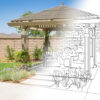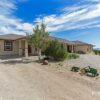As the fruits, and vegetables, from spring gardening pop up all over social media, many people may be wondering if fall planting is a good idea.
Bruce Gescheider, the owner of Moana Nursery, wants people to know that it certainly is.
“Fall planting is so good for plants,” Gescheider wrote. “Fall is when a plant focuses on root growth and strength because there is no competing top growth activity.”
What makes fall planting ideal for Northern Nevada’s climate?
He went on to explain that warm soil encourages root growth in the fall, and the roots will continue to grow until the ground freezes in winter. Then, in early spring, as the temperatures warm, the roots will either begin new growth or continue to develop at a faster rate.
“While spring plants get a slow start due to cool soils and transplant shock, fall plants are becoming well established,” he wrote. “When summer finally arrives, the fall-planted plant is far better equipped to deal with heat and drought.”
When plants can more adeptly handle heat and drought, they’re more able to thrive in Northern Nevada’s high desert environment.
Getting started with high desert gardening
While the idea of beginning a garden may be intimidating to some, Michelle Cartnick, a plant doctor at Moana Nursery, breaks it down into a few more straightforward steps.
First, she suggests that new gardeners utilize a container or raised bed to accommodate for the area’s poor soil. She suggests an area of 5-feet by 7-feet to begin.
“That’s a good place to start, just to give you enough space to grow a few things and not be too overwhelmed in the beginning,” she said.
Next comes the soil to fill the bed or container.
“It’s important to fill it with the correct soil,” she said. Cartnick recommends a mix of nutrient-dense Harvest Supreme mixed with Raised Bed and Potting Mix, which can act as a filler.
“The filler makes sure you have enough soil and adds the properties you need for drainage and aeration for roots to move in,” she said.
Gardeners can also add worm casings, compost or chicken manure to add more nutrients to the soil she said.
Once the soil and planter are in place, it’s time to select the plants, she said.
“That’s probably the hardest part, just because our season can be short, and we can have late-season frost or freezing temperatures at night,” she said. To help with selection, Moana Nursery offers a vegetable calendar, which explains how best to garden on a monthly basis.
Once the plants are in the ground, Cartnick emphasized the importance of fertilizing.
“A lot of the nutrients can get stripped out of the soil by getting taken out by the plant and also being run out by the amount of water that we need to give them,” she said. “So regularly fertilizing with an organic slow-release fertilizer is really important.”
Finally, she recommended patience—no matter if it is fall planting or spring planting or summer planting.
“Make sure you give the plants the time they need to mature,” she said. “Over time, the plants will thrive. As long as you fertilize and water, you should be fine.”
At Dickson Realty, our team of local experts knows about the best events, activities, and places to live in Northern Nevada. To learn more about how to enjoy the Reno/Sparks region, contact one of our Realtors today.



